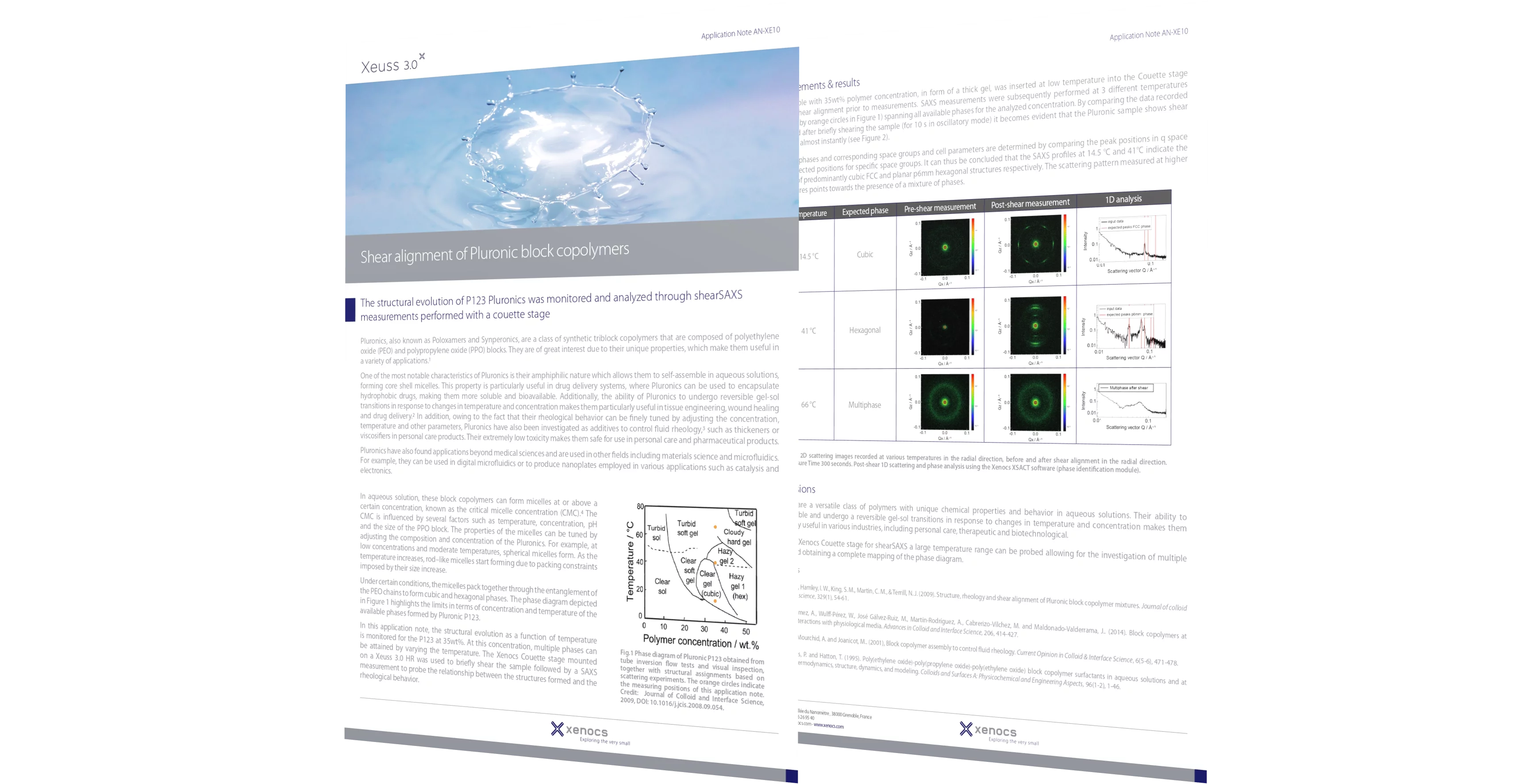The structural evolution of P123 Pluronics was monitored and analyzed through shearSAXS measurements performed with the Xenocs Couette stage
Poloxamers, also known under commercial names as Pluronics®, Synperonics® or Kolliphor® are a class of synthetic triblock copolymers that are composed of polyethylene oxide (PEO) and polypropylene oxide (PPO) blocks. They are of great interest due to their unique properties, which make them useful in a variety of applications [1].
One of the most notable characteristics of Pluronics is their amphiphilic nature which allows them to self-assemble in aqueous solutions, forming core shell micelles. This property is particularly useful in drug delivery systems, where Pluronics can be used to encapsulate hydrophobic drugs, making them more soluble and bioavailable. Additionally, the ability of Pluronics to undergo reversible gel-sol transitions in response to changes in temperature and concentration makes them particularly useful in tissue engineering, wound healing and drug delivery [2].
In addition, owing to the fact that their rheological behavior can be finely tuned by adjusting the concentration, temperature and other parameters, Pluronics have also been investigated as additives to control fluid rheology [3], such as thickeners or viscosifiers in personal care products. Their extremely low toxicity makes them safe for use in personal care and pharmaceutical products.
Pluronics have also found applications beyond medical sciences and are used in other fields including materials science and microfluidics. For example, they can be used in digital microfluidics or to produce nanoplates employed in various applications such as catalysis and electronics.
In aqueous solution, these block copolymers can form micelles at or above a certain concentration, known as the critical micelle concentration (CMC) [4]. The CMC is influenced by several factors such as temperature, concentration, pH and the size of the PPO block. The properties of the micelles can be tuned by adjusting the composition and concentration of the Pluronics. For example, at low concentrations and moderate temperatures, spherical micelles form. As the temperature increases, rod–like micelles start forming due to packing constraints imposed by their size increase.
Under certain conditions, the micelles pack together through the entanglement of the PEO chains to form cubic and hexagonal phases. The phase diagram depicted in Figure 1 highlights the limits in terms of concentration and temperature of the available phases formed by Pluronic P123.

Fig.1 Phase diagram of Pluronic P123 obtained from tube inversion flow tests and visual inspection, together with structural assignments based on scattering experiments. The orange circles indicate the measuring positions of this application note. Credit: J. of Coll. Int. Sci., 2009. DOI: 10.1016/j.jcis.2008.09.054
In this application note, the structural evolution as a function of temperature is monitored for the P123 at 35wt%. At this concentration, multiple phases can be attained by varying the temperature. The Xenocs Couette stage mounted on a Xeuss 3.0 HR was used to briefly shear the sample followed by a SAXS measurement to probe the relationship between the structures formed and the rheological behavior.
References:
[1] G. E. Newby, I. W. Hamley, S. M. King, C. M. Martin, and N. J. Terrill, Structure, Rheology and Shear Alignment of Pluronic Block Copolymer Mixtures, Journal of Colloid and Interface Science 329, 54 (2009). DOI: 10.1016/j.jcis.2008.09.054
[2] A. Torcello-Gómez, M. Wulff-Pérez, M. J. Gálvez-Ruiz, A. Martín-Rodríguez, M. Cabrerizo-Vílchez, et al., Block Copolymers at Interfaces: Interactions with Physiological Media, Advances in Colloid and Interface Science 206, 414 (2014). DOI: 10.1016/j.cis.2013.10.027
[3] S. R. Bhatia, A. Mourchid, and M. Joanicot, Block Copolymer Assembly to Control Fluid Rheology, Current Opinion in Colloid & Interface Science 6, 471 (2001). DOI: 10.1016/S1359-0294(01)00122-4
[4] P. Alexandridis and T. Alan Hatton, Poly(ethylene oxide)-poly(propylene oxide)-poly(ethylene oxide) Block Copolymer Surfactants in Aqueous Solutions and at Interfaces: Thermodynamics, Structure, Dynamics, and Modeling, Colloids and Surfaces A: Physicochemical and Engineering Aspects 96, 1 (1995). DOI: 10.1016/0927-7757(94)03028-X


































